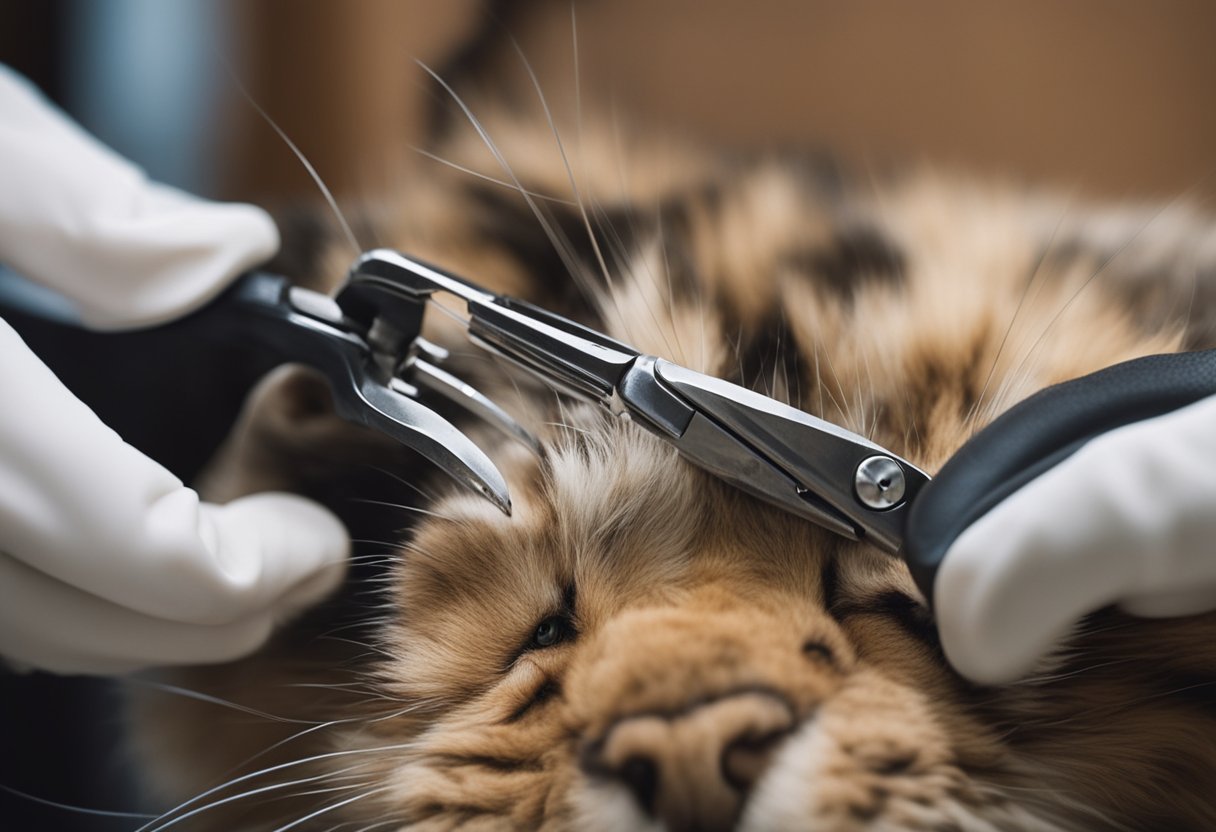Trimming Cats Paws: A Guide to Safe and Effective Claw Care
Cats are known for their sharp claws, which they use for various activities like playing, climbing, and hunting. However, these claws can also cause damage to furniture, carpets, and even people. To prevent this, it is important to trim a cat’s claws regularly. While trimming a cat’s claws may seem daunting, it is a straightforward process that can be done at home with the right tools and technique.

Understanding cat paw care is crucial before starting the process of trimming. A cat’s paws are sensitive and require proper care to prevent infections and other complications. Preparing to trim your cat’s paws involves selecting the right tools, including nail clippers or scissors, and choosing a comfortable and quiet location to perform the trimming. It is also important to consider your cat’s temperament and choose a time when they are relaxed and calm.
Key Takeaways
- Trimming a cat’s claws is an important part of cat paw care to prevent damage to furniture, carpets, and people.
- Preparing to trim your cat’s paws involves selecting the right tools and choosing a comfortable and quiet location to perform the trimming.
- It is important to consider your cat’s temperament and choose a time when they are relaxed and calm.
Understanding Cat Paw Care
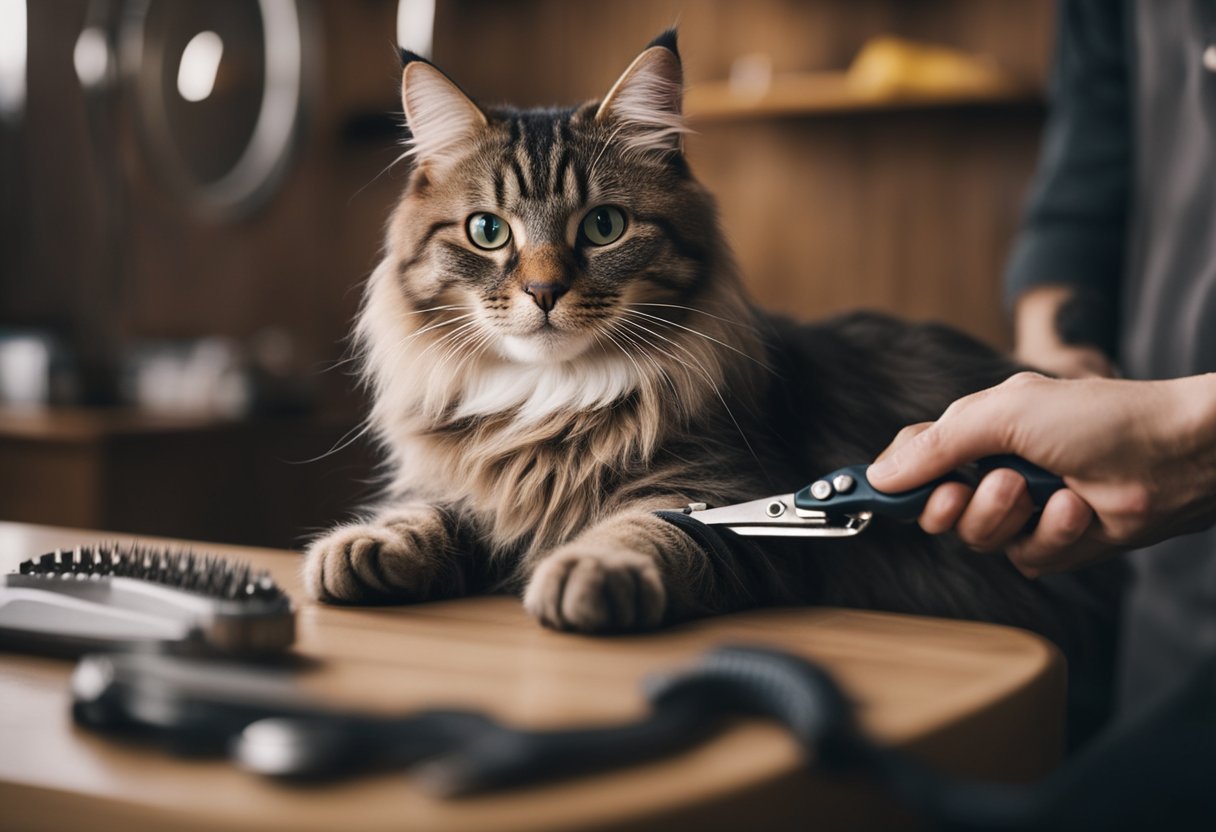
Anatomy of Cat Paws
Before diving into the importance of paw maintenance, it’s essential to understand the anatomy of cat paws. A cat’s paw consists of five toes, each with a claw, and a pad that provides cushioning while walking. The claws are retractable, and cats use them for various activities such as climbing, hunting, and self-defense. The pads help cats maintain balance and provide insulation against extreme temperatures.
Importance of Paw Maintenance
Maintaining a cat’s paw is crucial for their overall health and well-being. Regular paw maintenance can prevent various health issues such as ingrown nails, infections, and matting of fur. It’s also essential to keep the paw fur trimmed to prevent long and painful claws from digging in and damaging furniture and floors.
Owners can maintain their cat’s paw by regularly inspecting them for any signs of injury or infection. They can also trim the paw fur themselves if they feel comfortable using rounded scissors, but they must be careful not to cut the pads. If the cat retaliates when their paws are touched, it’s best to take them to a professional groomer.
In conclusion, understanding the anatomy of cat paws and the importance of paw maintenance is crucial for cat owners. By providing regular care and attention to their cat’s paws, owners can ensure their feline friends remain healthy and happy.
Preparing to Trim Your Cat’s Paws

Trimming your cat’s paws is an important part of their grooming routine. It helps prevent overgrown nails that can cause discomfort, pain, and even injury. Before you start trimming your cat’s paws, it’s important to gather the right tools, create a calm environment, and learn how to handle your cat’s paws properly.
Gathering the Right Tools
To trim your cat’s paws, you will need a few essential tools. These include:
- Cat nail clippers: Choose a pair of clippers that are specifically designed for cats. Avoid using human nail clippers, as they can crush the nail and cause pain.
- Styptic powder: This powder helps stop bleeding in case you accidentally cut the quick (the pink part of the nail that contains blood vessels and nerves).
- Treats: Treats can help distract your cat and make the experience more positive.
Creating a Calm Environment
Cats can be easily stressed, so it’s important to create a calm environment before trimming their paws. Choose a quiet room where your cat feels comfortable and safe. Close the door to prevent any distractions or interruptions. You can also play soft music or use a calming spray to help relax your cat.
Handling Your Cat’s Paws
Before you start trimming your cat’s paws, it’s important to get them used to having their paws touched. Start by gently touching their paws while giving them treats. Gradually increase the amount of time you touch their paws until they are comfortable with it.
When you’re ready to trim their nails, hold your cat gently but firmly. Use your thumb and forefinger to hold their paw and press gently on the pad to extend the nail. Then, use the clippers to trim the tip of the nail, being careful not to cut the quick. If you accidentally cut the quick and the nail starts bleeding, apply styptic powder to stop the bleeding.
By following these tips, you can prepare to trim your cat’s paws safely and effectively. Remember to take it slow and be patient, and always reward your cat with treats and praise for good behavior.
Trimming Technique
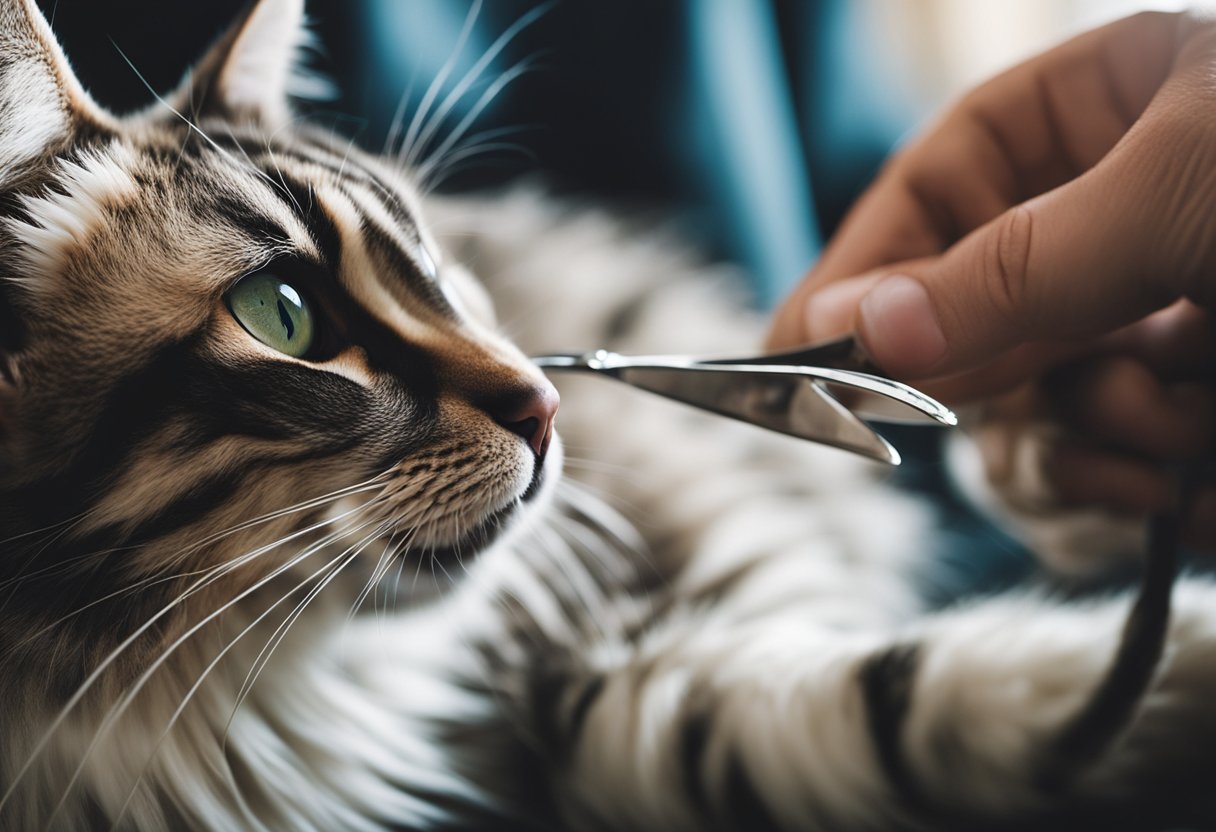
Trimming a cat’s claws is an essential part of cat grooming. It helps prevent the cat from scratching furniture, people, or other pets. Here are some steps to follow when trimming a cat’s claws.
Identifying the Quick
Before cutting a cat’s claws, it’s essential to locate the quick. The quick is a pinkish area in the center of the claw, which contains blood vessels and nerves. Cutting the quick can cause bleeding and pain to the cat. To avoid cutting the quick, use a bright light to illuminate the claws and identify the pinkish area.
Cutting the Claws
Once you’ve located the quick, it’s time to clip the claws. Use a sharp and sturdy pair of scissors or clippers to cut the claws. Hold the cat’s paw and press gently on the pad to extend the claw. Cut only the sharp tip of the claw, avoiding the pinkish area. If you’re unsure about where to cut, it’s better to cut less than to cut too much.
Safety Tips
Trimming a cat’s claws can be a challenging task, especially if the cat is not used to it. Here are some safety tips to keep in mind:
- Use a proper pair of scissors or clippers designed for cats.
- Keep a styptic powder or cornstarch nearby to stop bleeding in case you accidentally cut the quick.
- Use treats and positive reinforcement to make the cat feel comfortable and relaxed during the process.
- If the cat is too nervous or aggressive, consider seeking professional help from a veterinarian or a professional cat groomer.
By following these steps and safety tips, trimming a cat’s claws can be a stress-free and straightforward process for both the cat and the owner.
Post-Trimming Care
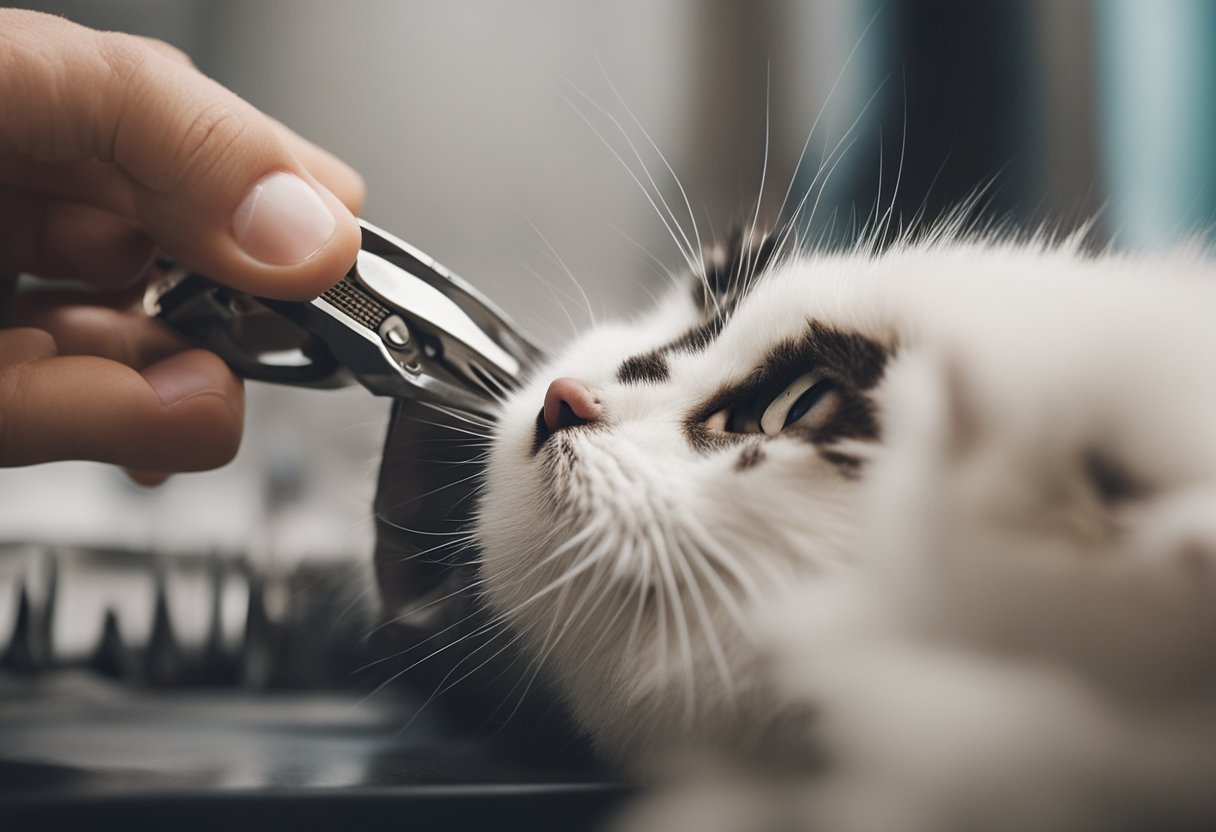
After trimming your cat’s paw fur, it’s important to observe their behavior and take care of their paws properly. Here are some tips to help you with post-trimming care:
Observing Your Cat’s Behavior
After trimming your cat’s paw fur, it’s normal for them to feel a bit uncomfortable or even annoyed. They might lick their paws excessively or try to scratch them. However, if you notice that your cat is limping, avoiding putting weight on their paws, or showing signs of pain, it’s important to contact your veterinarian immediately. These symptoms could indicate an injury or infection that needs medical attention.
Paw Inspection and Cleaning
To prevent infections and keep your cat’s paws healthy, it’s important to inspect and clean them regularly. After trimming their paw fur, take a closer look at their paws and make sure there are no cuts, bruises, or signs of inflammation. If you notice any of these symptoms, contact your veterinarian for advice.
To clean your cat’s paws, you can use a damp cloth or a pet-safe paw wipe. Gently wipe their paws, including the area between their toes, to remove any dirt, debris, or bacteria. Avoid using harsh chemicals or soaps that could irritate their skin or cause allergic reactions.
In addition to cleaning their paws, you can also apply a pet-safe moisturizer or paw balm to keep their paws soft and healthy. This can be especially helpful if your cat spends a lot of time outdoors or on rough surfaces that could dry out their paws.
By following these post-trimming care tips, you can help your cat stay comfortable and healthy after their paw fur trimming.
Addressing Complications
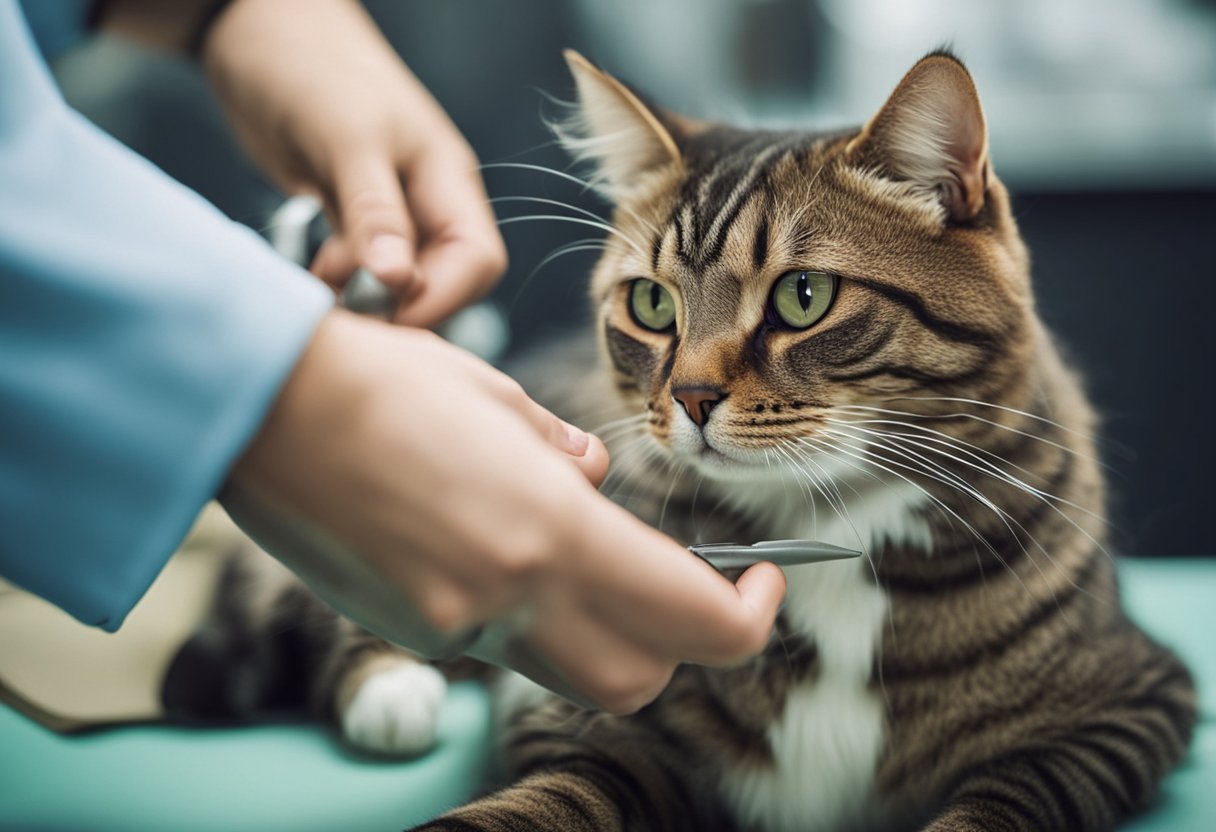
Trimming a cat’s paw fur can sometimes lead to complications, but most of these complications are minor and can be addressed at home. However, if the cat experiences severe pain, excessive bleeding, or other concerning symptoms, it is important to seek veterinary attention immediately.
Accidental Bleeding
Accidental bleeding is one of the most common complications that can occur when trimming a cat’s paw fur. If a cat’s paw starts bleeding during the trimming process, the owner should immediately apply pressure to the affected area using a clean cloth or gauze. The pressure should be maintained for several minutes until the bleeding stops. If the bleeding persists, the cat owner should seek veterinary attention.
Claw Infections
Claw infections are another potential complication that can occur when trimming a cat’s paw fur. If the cat’s paw fur is not trimmed properly, it can lead to ingrown nails or other claw-related problems. This can cause the cat to experience pain, swelling, and redness in the affected area. If the cat displays any of these symptoms, the owner should clean the affected area with warm water and mild soap. If the symptoms persist, the cat owner should seek veterinary attention.
When to See a Vet
In some cases, complications from trimming a cat’s paw fur can be severe enough to require veterinary attention. If the cat experiences excessive bleeding, severe pain, or other concerning symptoms, the owner should seek veterinary attention immediately. Additionally, if the cat has a pre-existing medical condition or is taking medication, the owner should consult with a veterinarian before attempting to trim the cat’s paw fur.
In conclusion, trimming a cat’s paw fur can lead to complications, but most of these complications are minor and can be addressed at home. By taking the necessary precautions and following proper trimming techniques, cat owners can help ensure that their pets remain healthy and happy.
Maintaining Claw Health
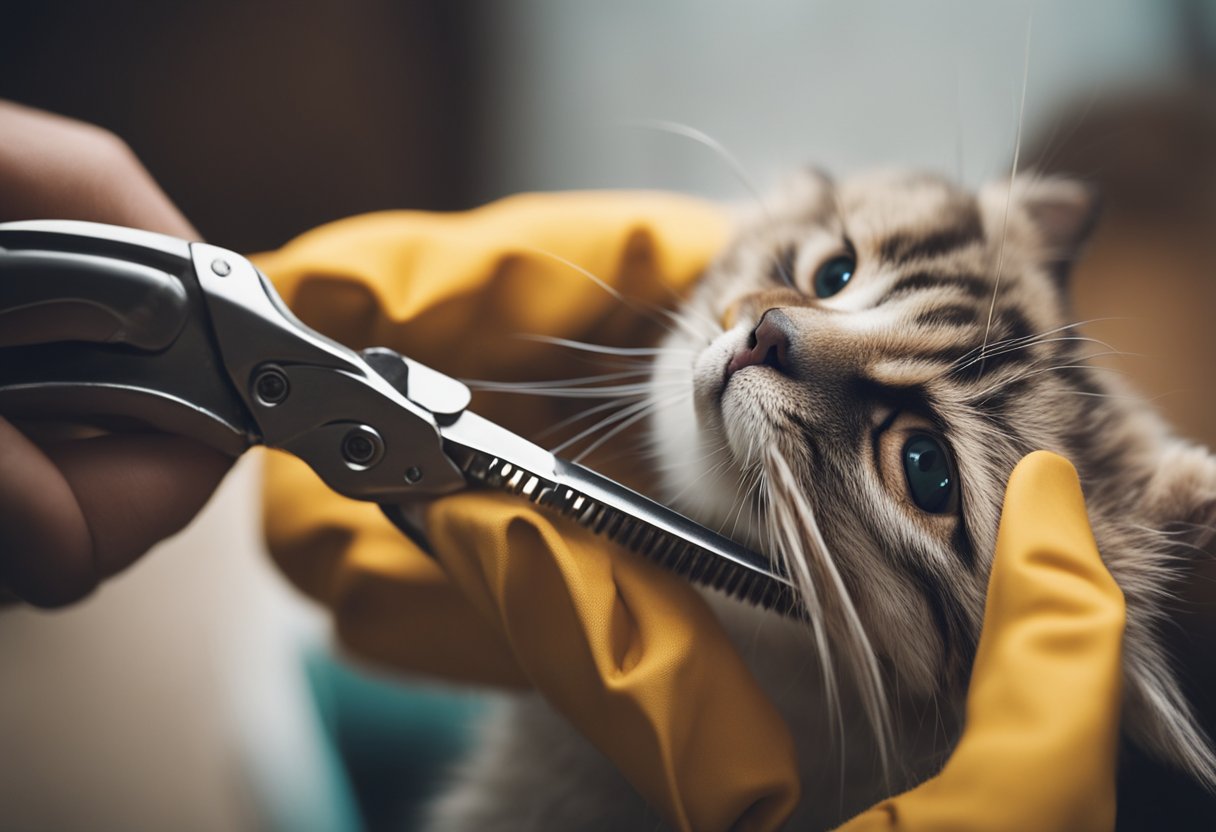
Cats’ claws are essential for their survival, and keeping them healthy is crucial for their overall well-being. Here are some tips on how to maintain your cat’s claw health.
Regular Trimming Schedule
Regularly trimming your cat’s claws is essential to prevent overgrowth and breakage. A good rule of thumb is to trim your cat’s claws every two to three weeks. However, the frequency may vary depending on the cat’s lifestyle and activity level.
To trim your cat’s claws, use a specialized cat nail clipper and make sure to avoid cutting the quick, which is the pink part of the nail where the blood vessels are. If you accidentally cut the quick, it may cause pain and bleeding, so be sure to have some styptic powder on hand to stop the bleeding.
Providing Scratching Posts
Cats need to scratch to maintain their claw health and to mark their territory. Providing your cat with a scratching post or pad can help prevent them from scratching your furniture or carpets.
When choosing a scratching post, consider the material. Cats prefer rough surfaces, so a post covered in sisal or cardboard may be more appealing to them. Additionally, make sure the post is tall enough for your cat to fully stretch out and sturdy enough to support their weight.
In summary, maintaining your cat’s claw health is essential for their well-being. Regularly trimming their claws and providing them with a scratching post can help keep their claws healthy and prevent destructive scratching behavior.
Resources:
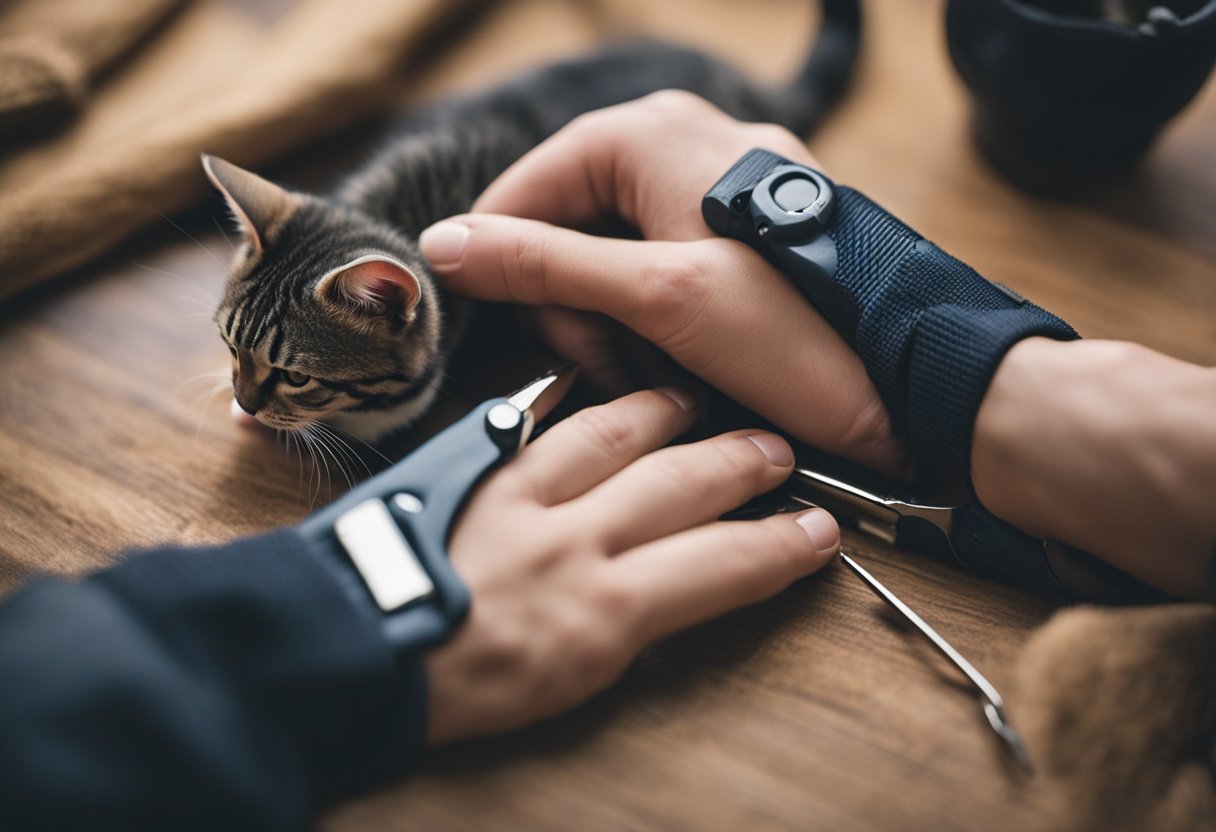
Here are some external links that provide more information on trimming cats’ paw fur:
- Catster: This article provides tips, facts, and frequently asked questions about trimming cats’ paw fur. It explains that trimming the claws is beneficial for the owner because it prevents long and painful claws from digging in and it means that the cat is less likely to damage furniture and floors. The article also advises on how to trim the fur and what tools to use.
- Petkeen: This article explains that cats do not need their paw fur trimmed for good health and hygiene, but it is an acceptable practice. It advises that if there is no reason to trim the fur, there is no need to bring clippers near the cat’s feet and risk cutting them.
- Hepper: This article discusses when and why trimming cats’ paw fur is necessary and when it is not. It explains that unless the fur is causing an issue, like being matted and filthy, preventing proper walking, there is no need to trim it. The article also provides grooming tips for cats’ paw fur.
- DorkyCats: This article advises that cat owners should not trim the fur on their cat’s paws unless it creates a problem for the cat. For example, if it is matted and filthy, preventing proper walking. The article also warns against cutting out whiskers among the paws and legs, as they are essential for cats.
- Betterpet: This article provides a step-by-step guide on how to trim cats’ claws. It advises on how to locate the “quick” of the claw and avoid it during the nail clipping process. The article also provides tips on how to make the process less stressful for the cat.
These resources provide a wealth of information on trimming cats’ paw fur. It is important to note that while trimming the fur is not necessary for good health and hygiene, it can be beneficial for the owner and the cat. It is also important to follow the proper grooming techniques and tools to avoid injuring the cat.
Conclusion
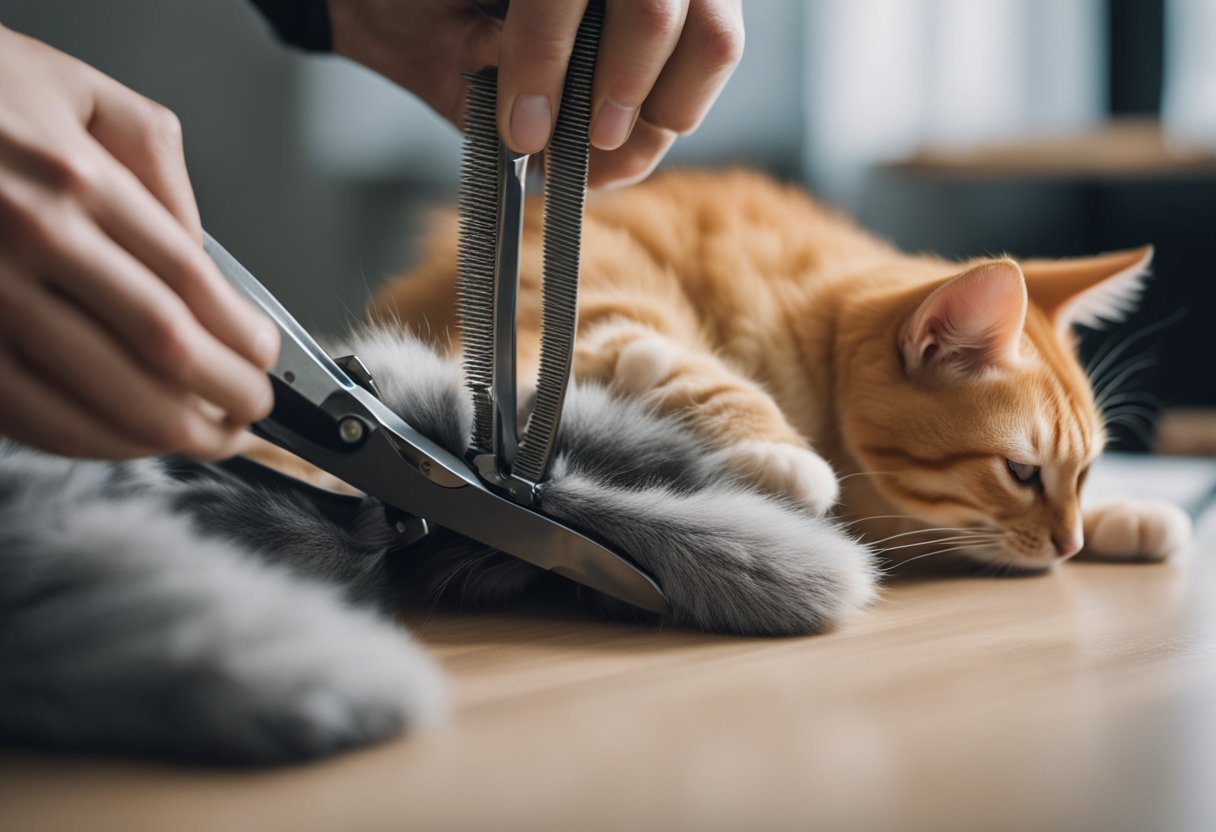
Trimming a cat’s paw fur is not necessary unless it causes a problem for the cat. Cats have paw fur for a reason, and it serves several purposes. The fur between their paws helps them walk silently and insulates them from the cold. Additionally, the fur on their paws can help them with grooming and provide a good grip when climbing.
If a cat’s paw fur becomes matted and dirty, it may be necessary to trim it. However, it is important to be careful when doing so. Cutting too close to the skin can cause pain and bleeding, and it is essential to use appropriate tools and techniques to avoid injuring the cat.
Professional groomers may trim a cat’s paw fur to tidy things up, but it is not necessary for good health and hygiene. If there is no reason to trim the fur, it is best to leave it alone and avoid the risk of injuring the cat.
In summary, trimming a cat’s paw fur is a personal choice, and it should only be done if necessary. If a cat’s paw fur is causing a problem, it is important to be careful when trimming it and to use appropriate tools and techniques to avoid injury. Otherwise, it is best to leave the cat’s paw fur alone and let it serve its purpose.
Frequently Asked Questions

How can I safely trim the fur on my cat’s paws?
Trimming the fur on your cat’s paws can be a bit tricky, but it’s not impossible. The best way to approach this task is to use a pair of small, sharp scissors and to trim the fur carefully, avoiding the skin and paw pads. It’s important to be very gentle and to take your time, especially if your cat is not used to having her paws handled. If you’re unsure about how to do this, it’s always best to consult with a veterinarian or a professional groomer.
What are the steps to treat my cat’s dry and cracked paw pads?
Dry and cracked paw pads can be a common problem for cats, especially during the winter months. To treat this issue, you can apply a small amount of petroleum jelly or paw balm to your cat’s paw pads. It’s important to avoid using human lotion or creams, as these can be harmful to cats. Additionally, it’s a good idea to make sure that your cat is well-hydrated and that she has access to plenty of clean water.
Which cat breeds naturally have tufts of fur between their toes?
Some cat breeds, such as the Maine Coon and the Norwegian Forest Cat, naturally have tufts of fur between their toes. This is known as “feathering” and it’s believed to help these cats navigate through snow and other rough terrain. While this fur can be quite beautiful, it can also be prone to matting and tangling. If your cat has feathering, it’s important to keep it well-groomed and free of tangles.
Is it necessary to clean my cat’s paws after using the litter box?
While it’s not strictly necessary to clean your cat’s paws after using the litter box, it can be a good idea to do so. This can help to prevent the spread of bacteria and other harmful substances throughout your home. To clean your cat’s paws, simply use a damp cloth or paper towel to wipe them down gently.
Why does my cat have excessively long hair on her feet?
Some cats, particularly long-haired breeds, may have excessively long hair on their feet. While this can be quite beautiful, it can also be prone to matting and tangling. Additionally, long hair on the feet can make it difficult for cats to walk and can even cause them discomfort. If your cat has long hair on her feet, it’s a good idea to trim it regularly to keep it free of tangles and to help your cat stay comfortable.
Should I regularly trim my cat’s paw fur for health or hygiene reasons?
Regularly trimming your cat’s paw fur can be a good idea for both health and hygiene reasons. Trimming the fur can help to prevent matting and tangling, which can be uncomfortable for your cat. Additionally, trimming the fur can help to prevent the accumulation of dirt and other debris, which can lead to infections and other health issues. If you’re unsure about how to trim your cat’s paw fur, it’s always best to consult with a veterinarian or a professional groomer.
People also ask
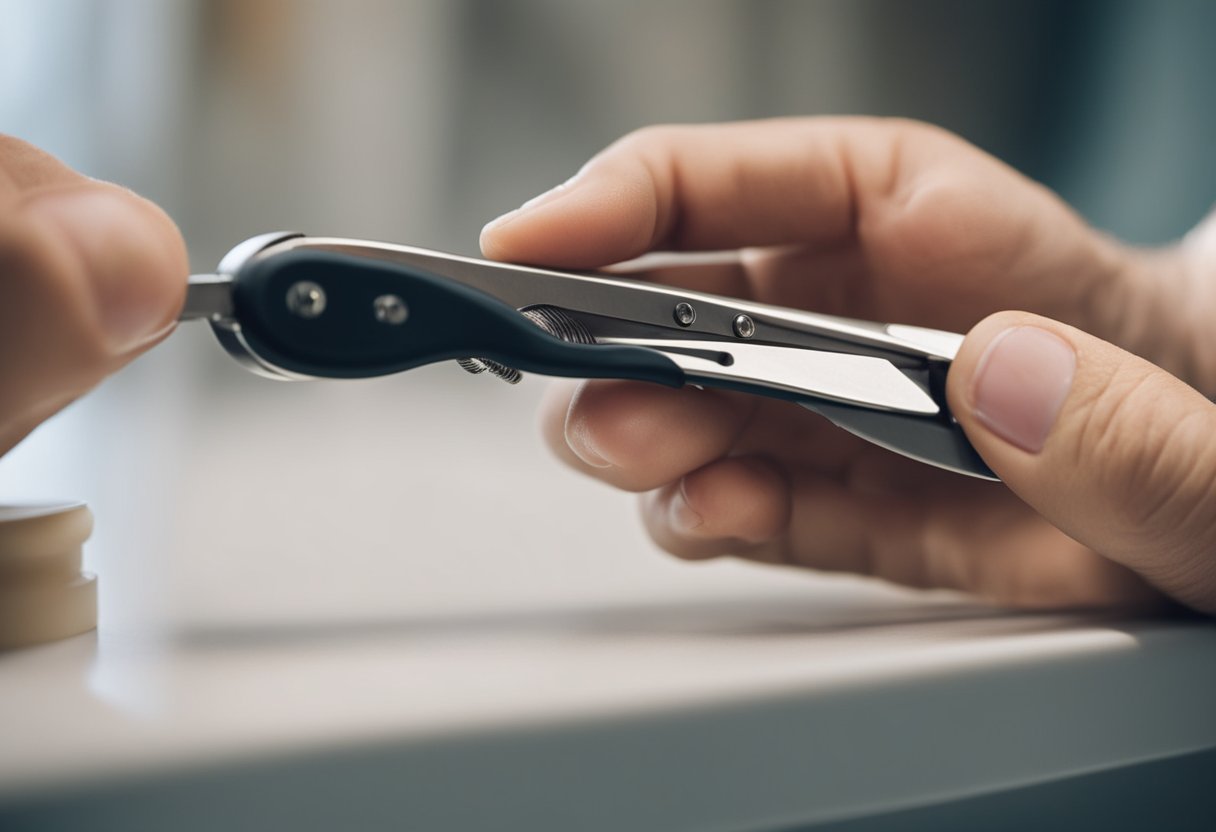
When it comes to caring for cats, many cat owners have questions about trimming their cat’s paws. Here are answers to some common questions:
Can you trim the hair on cats paws?
Yes, you can trim the hair on a cat’s paws. In fact, trimming the hair on a cat’s paws can help prevent matting and reduce the amount of litter that gets tracked around the house. However, it’s important to be careful when trimming a cat’s paws to avoid cutting the paw pads or causing the cat discomfort. Rounded scissors can be used to trim the hair, and professional groomers can also provide this service.
Is it normal for cats to have hair on their paws?
Yes, it is normal for cats to have hair on their paws. This hair helps protect the paw pads and provides insulation. However, if the hair on a cat’s paws becomes matted or dirty, it can be trimmed to help keep the cat clean and comfortable.
Should I trim my cat’s fur?
Whether or not to trim a cat’s fur depends on the individual cat and their grooming needs. Some cats may benefit from having their fur trimmed to prevent matting or reduce shedding, while others may not need to be trimmed at all. It’s important to consult with a veterinarian or professional groomer to determine whether or not your cat would benefit from having their fur trimmed.
How do you cut a cat’s paws?
When cutting a cat’s paws, it’s important to be gentle and use rounded scissors to avoid injuring the cat. The hair on the paws can be trimmed up to the level of the paw pads, but care should be taken not to cut the pads themselves. If a cat is resistant to having their paws trimmed, a professional groomer can provide this service.
Is it safe to trim cat claws?
Yes, it is safe to trim a cat’s claws. Trimming a cat’s claws can help prevent them from scratching furniture or people, and can also reduce the risk of the cat’s claws becoming ingrown or infected. However, it’s important to be careful not to trim the claws too short, as this can cause pain and bleeding.
Should I clean my cat’s paws?
Yes, it’s a good idea to clean a cat’s paws regularly. This can help prevent dirt and debris from accumulating between the toes, which can lead to infections or discomfort. A damp cloth can be used to gently clean the paws, and a veterinarian or professional groomer can provide advice on how often to clean a cat’s paws based on their individual needs.
Should I moisturize my cat’s paws?
Moisturizing a cat’s paws can help keep them soft and supple, but it’s important to use a moisturizer that is specifically designed for cats. Human moisturizers can be harmful to cats if ingested, so it’s important to choose a pet-safe product. A veterinarian or professional groomer can provide advice on the best moisturizer to use for your cat’s individual needs.
